Note: This is one article in a series about horse vision. I’ve compiled all of them, including more information and references, in this blogpost: Horse Vision.
Horses are animals who evolved in open grasslands. They’re designed to be awake and graze most of the day and night. Because of this they have excellent vision in scotopic (low-light) conditions. It’s hard for us to imagine because we have opposite needs – to see with acuity and color in the daytime. To have good scotopic vision, the anatomy of a horse’s eye is different than ours. This affects their behavior in basic ways.
Sometimes your horse’s pupil looks bluish-grey. What you’re seeing is the tapetum lucidum, a structure that reflects light back through the photoreceptor layer of the eye so that the horse has a high sensitivity to light, especially light reflecting off of the ground. For an animal that needs to graze at night, and also to see predators, and then move quickly away from them, over uneven terrain, without stumbling, this is a useful adaptation. But there’s a trade-off. We humans don’t have a tapetum lucidum and our night vision is poor. However, we have the ability to adjust our eyes quickly from bright light to dark. Horses do not. It takes horses much longer to see in scotopic conditions, but once they do, they see far more than us.
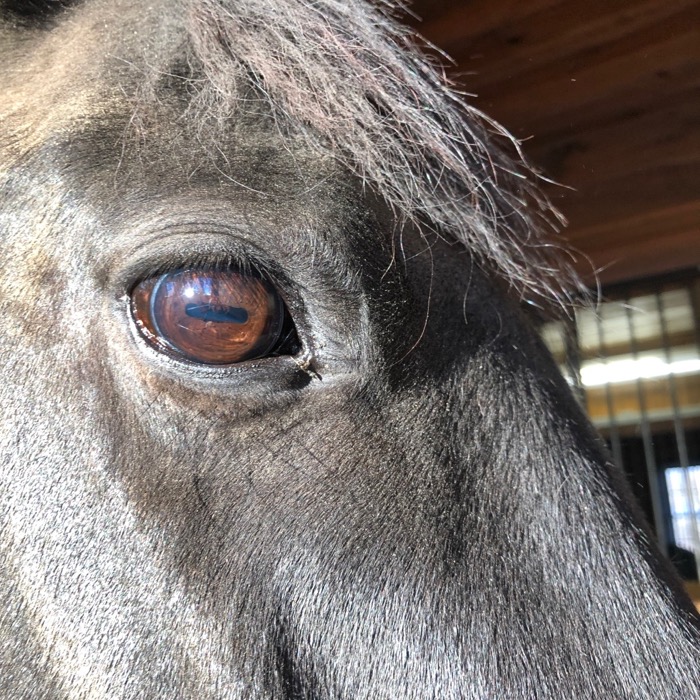
Walk from sunlight to the interior of a barn.

In five minutes, your eyes have adjusted and this is what you see.
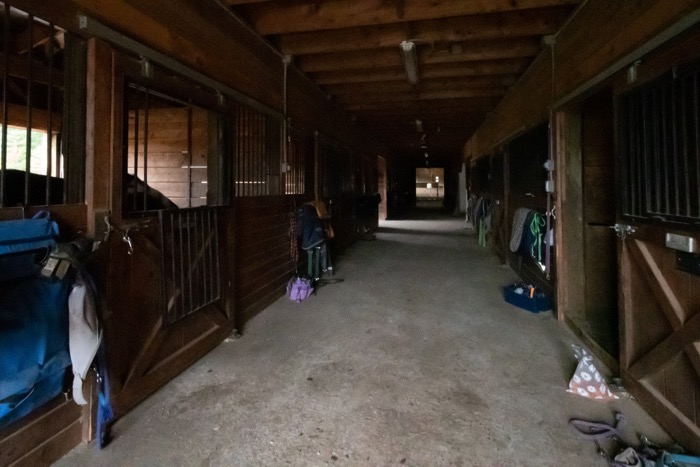
This is what your horse sees. Yes. That dark.
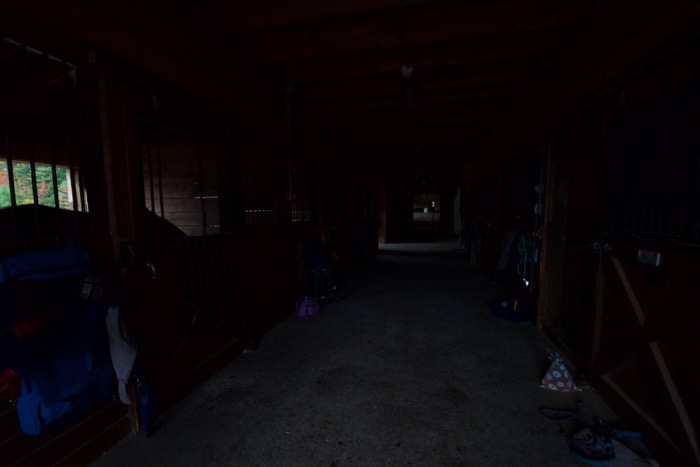
No wonder there are behavior “issues” going into enclosed spaces, or why your horse trips over a lead rope on the aisle’s floor and panics. And why you should always put those saddle racks down when not in use, and why door latches should be smoothly tucked out of the way. The horse can’t see them!
However, in twenty minutes, this is what your horse sees – it’s brighter and in more detail than you can ever perceive. Which is why you won’t notice a sudden movement at the far end of the barn, but your horse will.
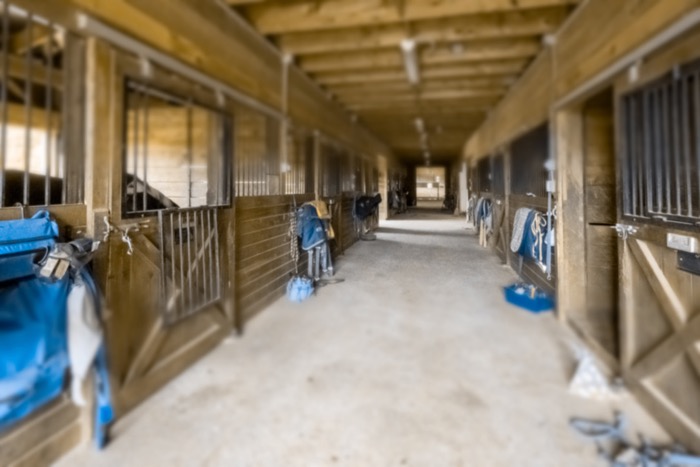
Horses need to flee from danger, and so have an innate fear of small, enclosed, dark spaces. Here’s one.

The above photo is how you see the trailer. It doesn’t look so bad. But the photo below is how the horse sees it – the interior is much more of a mystery. Remember that they see in panorama, so there are wide open spaces on both sides. (This photo is also adjusted for their visual acuity and color blindness.) I can understand why the horse, of all of their options in this scene, wouldn’t want to go into that black hole!

This doesn’t mean that loading your horse into the trailer has to be fraught with conflict and pressure. The first thing to do make it brighter inside. If your trailer has them, open the front doors. Here’s the same trailer, viewed with a horse’s vision, with that one easy change. Now the horse can see what they’re getting into.
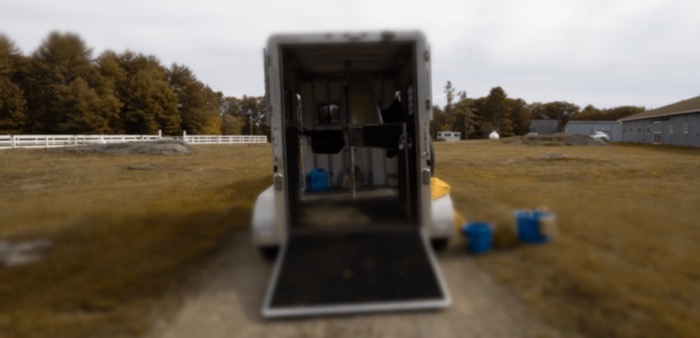
Many trailers have interior lights. Make use of those, too.
Here’s a horse who is an experienced show horse and usually loads easily. However, she’s never seen this trailer. Note how her body language is tense, she’s stopped at the ramp, and is lowering her head to try to get as much light as possible reflecting off of her tapetum lucidum, and also to get the floor of the trailer into focus using her line of acuity.

We walked her away, opened the doors at the front of the trailer, and had her approach again. She walked right on.
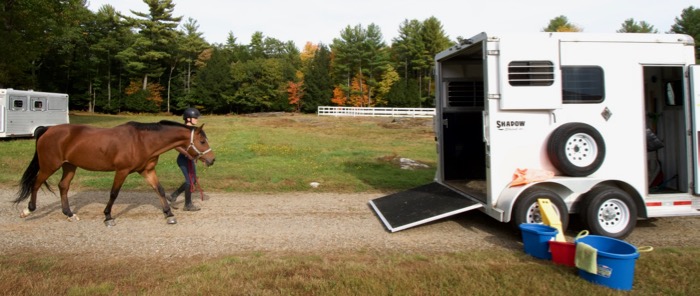
Of course, thoughtful, reward-based training should be part of the picture, too. (I’ve blogged about that. Check the trailering category on the right-hand side of this page.)
When going from shade to sun, a human’s pupil constricts in diameter to let less light in. A horse evolved in wide open spaces, where brightness remains rather constant over stretches of time. They didn’t need to adjust quickly from light to dark, so the horse’s pupil can constrict only a tad. Instead they have corpora nigra – that’s the raggedy part of the iris that hangs into the pupil and is particularly effective at shading out sunlight from above.
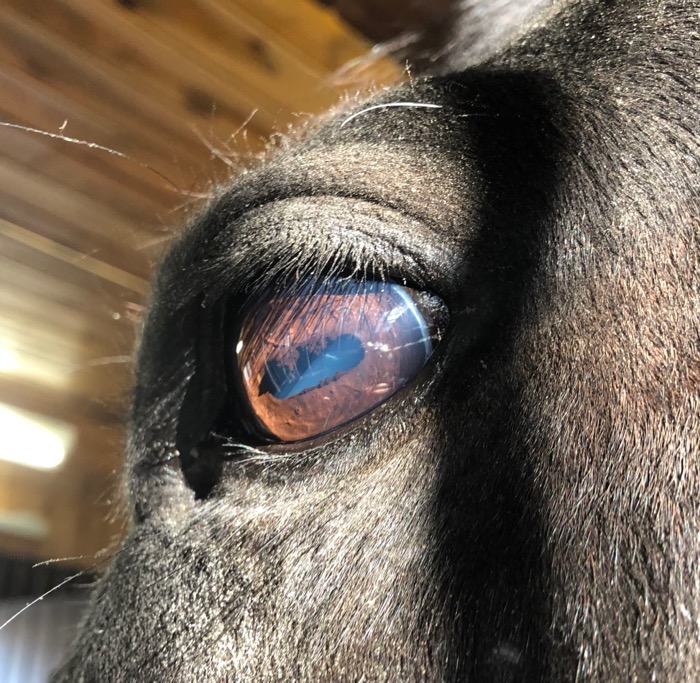
This design is perfect for a grazing animal whose head is usually on the ground and whose eyes are scanning low across the horizon. The corpora nigra acts as an awning! When a horse’s head is up and in very bright light, the pupil constricts and the corpora nigra partially covers the iris to protect it from being harmed by the sun. It’s like when we try to see through squinted eyes – you see only enough to fumble your way around.
The takeaway from this is that you might want to try a moonlit ride on your horse. You won’t be able to see where you’re going, but your horse will. On the other end of the (literal) spectrum, when riding out on a wonderfully sunny day, if you head into the shade of the woods, slow down and take your time. Your horse’s eyes can’t be rushed.

NOTE: The science of sight is complex. There are several ways for an eye to adjust to different lighting conditions, including the one that we are most aware of – the dilating pupil. There’s another one – chemical – the photoreceptors go through a chemical change to alter their sensitivity to light. When in bright light, the photoreceptors go through bleaching, and it takes more light to trigger them. When in darkness, they chemically increase their sensitivity to light to enable them to register detail in dark conditions. This chemical change is the major way that the horse adjusts from light to dark, and this is what takes so long. For more information, see this text book Equine Ophthalmology, 3rd Edition, Brian C. Gilger (Editor) especially Chapter 12 “Equine Vision” by Paul E. Miller and Christopher J. Murphy. You can read excerpts here on Google Books. An earlier version of the “Equine Vision” chapter is available here.


The articles have been so informative and well written, and the pictures are great. Thanks to you and Steve.
Thank you for the comment. I learned a lot doing this, and am still learning. Am currently in an email conversation with a scientist in London who is doing fascinating work in comparative eye anatomy and function.
Wow, I had no idea it took them so long to adjust to the change in brightness. That certainly explains some of the reactions I sometimes see in my horse. Thanks for posting this. 🙂
You’re welcome!
Excellent and extremely helpful article! The photos really help to illustrate the points.
I’ve noticed one of our horses (an appy) squints when I turn on the barn lights in the morning. I turn them on gradually in sets but the light seems to bother him more than the rest of the horses. I wonder how much variation in light sensitivity there might be between different horses or breeds?
Yes! Some horses do have light sensitivity, and I’ve known ones with eye issues who wear UV protective masks whenever outdoors to prevent progression of disease. Appaloosas are known for being at high risk – it’s genetic and exacerbated by that lack of pigment around the eyes. I’d get him checked by a veterinarian (if you have one in your area, an eye specialist) and go a preventative route 🙂 BTW, my first horse was a leopard appy. Great personality.
I never fail to learn something interesting in your posts Terry, and the only creature I tend is one old cat!
A cat that is very lucky to have you 🙂
Thank you very much for this; I literally gasped when I saw what the horse sees going into the barn….! This kind of information is so important to engender better understanding and consequently better welfare for horses.
You’re welcome!
Sometimes I must bring my horses in from the dark field to a brightly lit barn. I try to avoid it if possible as it takes so long for them to adjust and then to go out to the pitch black agin must be quite straining on the eyes. I’d be interested to see what the bright barn looks like from their perspective compared to the dark outside xx
The research that I found discussed light to dark conditions – not much on dark to bright light. I’m sure it isn’t comfortable, but I’m not sure how long it takes for them to stop squinting 🙂
Interesting thanks
Thanks for reading!
Really helpful information. The pictures — especially of the horse’s eye — are great. Thank you.
I have a lot of photos of me reflected in the eye 🙂 Getting a good photo took many tries!
I worry about leaving a fly veil on at night time, is there a problem with this , do i need a special one, thank you
Horses have excellent night vision, so your horse can probably see adequately through that veil. However, if the flies, etc. are only prevalent in the daytime you might want to take it off. However, in many areas, mosquitos are at their worst in early am and at dusk, so leaving it on for protection at those times might be the best for your horse. At the least, though, I like to check my horse’s eyes daily, and brush dirt off of the mask, and also brush my horse’s head. It can get itchy under that mask 🙂
Great informative article.
Thanks! I learned a lot researching it.
Thank you for posting….this is a good reminder to slow down and have a bit more patience with our companions!
Yes!
fabulous article thanks!
Thanks for your comment.
Great article Look at Bockmann Trailers in the US. Popular in 38 countries for 60 years- inside is majority white calming and virtually inviting the horse to enter a safe space. More info only at BockmannTexastrailers.com
That is such important information for horse owners. I’m sure most have no idea that this is how they see…it explains so much! Thank you
Thanks. Check out the other blogs I have about horse vision. I’ll be compiling them all into one comprehensive article soon 🙂
What a fascinating & informative article. The clear explanation & use of comparative photos, really helps to clarify what our horse is coping with: what a marvel Nature is!
This will help me help my pony cope better with new challenges.
I wrote it exactly for that reason – a little understanding of the world from your animal’s perspective can make all of us face our challenges better 🙂
If it was even a little dark out I had to put the lights on in the trailer so AK would go in, I even had an extra light installed. He would go right in as long as the lights where on.
That’s great that you realized that adding light gave your horse the confidence to walk into the trailer, and then that you installed even more light. Well done!
Excellent article!
Thanks!
This information with the accompanying pictures is FANTASTIC! Nothing like a picture for we humans to help information stick in our brain 🙂 !
My trainer shared this on facebook…. Thank you Terry for creating this great article! My Paint mare, Dixie, thanks you too!
Thanks to my husband who is a geek who could translate the science into those photos. Tonka says hello to Dixie.
A great article. Thanks.
Thank you for your comment 🙂
I have a horse that reacts to shafts of sun coming thru the arena window around 2ish in the afternoon. As soon as the sun hits his eyes, he throws his head and balks. He does not even want to go to that end of the ring when he sees the sun is out. As soon as the sun goes behind a cloud or we have a gray day he is fine. I’ve had the vet check his eyes, seems fine, no problems. I don’t see other horses reacting this way when they go through the sun shafts. Any idea why my horse is so sensitive to it or do you think it’s a learned behavior?
It could be a learned behavior. Once bad experience with a shaft of light, and they’re fearful after. Or, it could be that, like us, a bright beam of light temporarily blinds him, and that triggers unease. There’s some new info coming out about sunlight triggering the trigeminal nerve, which can cause sudden pain- this research is being done in the case of head shakers, but maybe your horse experiences it in his own way.
What a wonderful article! The horse I currently lease is a Welsh Cobb (size LARGE!!). He definitely has issues going in and out of two barns and the indoor arena where he lives. I always wondered if it was due to his sight. Our indoor arena’s footing was just changed two weeks ago from a dark to very light colored material. He walked right in the first time and seemed more calm than usual. He also had issues in the past with sunlight streaming onto the dark footing as another reader mentioned.
Interesting! A dressage show that I went to had just installed light-colored footing. The ring was outside in bright sunshine. Many horses, including Tonka, hesitated going on it because it was different and reflective. Sunlight in patches is often a problem. Horses do have depth perception, but things like that take some looking at for them to know it’s not a chasm.
great article; trail riding difficulties with spooking when the day is longer and the sun is low and patchy bright can cause issues with spooking and fear based reactions.
Yes, those bright patches can scare me, too 🙂
Thank you so much for sharing and for your willingness and desire to explore the subject to help humans understand the nature of the horse. Great work! Love it…
It’s a fascinating subject!
Thank you for responding!;-) ❤️
Most enlightening ! I notice that my blue-eyed ponies take longer to accept entering a darker place ? Are there any other specific factors at play with them ?
Great question! The blue eyes are not more susceptible to eye abnormalities, BUT pink skin (which can be associated with blue eyes) does tend more towards problems, including skin cancer. Appaloosas, with their pink skin and genetics, tend towards eye ailments. This is a good overview: https://aaep.org/horsehealth/common-equine-eye-myths
Love this article.
Thanks! Check out my other articles on horse senses. Fascinating to learn 🙂
This is very interesting! I often wondered if my horse has eye sight issues as she’s very spooky riding in the arena when it’s dark and squints when the barn lights are first turned on. This might make sense now! So she leaves a well lit barn and walks through an unlit yard to get to the arena. The arena only has lights on one side so there are dark unlit areas and incidentally these areas are where she is spookiest. I’d love to hear your thoughts on this? Perhaps I’m better off riding her without any lights?
It’s more difficult for the eyes to adapt from bright light to dark than the other way around. Perhaps in this case those dark areas give her no clues as to what is there. You could spend some time standing in the darker areas, letting her acclimate, so that she can see for herself that there’s nothing to worry about. Make it highly rewarding for her. Can you walk her there during the daytime so that what’s there is familiar?
Very interesting and informative information… good article
Thanks!
Thank you, your examples help confirm my observations.
I have had experience with two horses in their late teens gradually becoming spooky at leaves moving in trees, ripples on water and large vehicles moving at speed on road. I had one mare for ten years prior to this and the gelding I have had for three years so the changes are not related to training issues I have had their sight checked with nothing found. However, my feeling is that their issues are related to their sight – age related deterioration??
Just like humans, horses vary in their visual acuity, and that can change with age. We get to wear glasses, they don’t 🙂 Also, it might be that their other senses were also changing. Read my blogpost about horse hearing.
BTW, how did you find my blog?
Extremely interesting and informative.
Thanks for letting me know that it was useful!
Very good read.
Thank you
🙂
Thank you for the clarity of a complicated topic so I understand. Your examples were also helpful. I hope you share often on subjects related to horses.
I blog once or twice a week. Some of the blogs are deep delves like this one, others are more comic relief (which happens when you have a horse!)
Very interesting.
The science of senses is fascinating. I’m currently researching touch. Stay tuned for that blog!
Good article and clear, concise explanations of why our horses seem to be more cautious if moving forward into spaces not well lit. I have absolutely no issue going slower for my mare so she feels safe. I appreciate this because with better knowledge comes understanding. Ultimately we are safer also as handlers. Thanks again
I have a saying that I live by: the slower you go, the faster you’ll get there.
Really interesting and practical help too. I have wondered how the horses find me in the middle class f the field in dim light when I need my torch!
They see you coming 🙂 Luckily, the skunks and other critters do, too, and hopefully stay out of your way!
Thank you for sharing this! I found it very interesting and informative. I now know how to better help my mare when loading her on the trailer.
You also stated what I have been telling fellow riders, horses are fine on Moonlit rides. I learned this many years ago when in 4-H, we rode the trails at night to build confidence and learn to trust our horse.
Yet another reason to support 4-H!
This is an informative amazing article. I had no idea the complexity of the horses eyes. I understand reasons now why sometimes my horse will hesitate when trail riding going from sun into shadows from trees.
Thank you for this comment. It’s exactly why I wrote the article – so that riders will give their horses a little bit more time in these situations. Enjoy your rides!
Very interesting article on horse vision adaptations.
🙂
Thank you for this information
, my horse got dilated pupils and was in stand blind after eating datura plants. After 2 months she has her sight back, but I think she sees different then before, but she is still night blind. Do you have any advice if I can help her adjusting her vision in the night?
Many thanks
Gaya
I had to look up datura plants and their toxicity. Your horse is lucky to be alive! I don’t have any advice to help her adjust her night vision. That’s for your vet to help you with. But, I would think through what she needs to be able to see to stay safe and calm and how you can adapt her environment for that. If she can still see contrast well, can you paint white lines on fences, water troughs, etc. to help her? Can you create consistent footing so that she knows when she’s going from one place to another? Are there sounds and smells that you can place in areas that she has trouble seeing in? I wish you and her the best. Let me know how it goes.
Amazing article! Thank you I will pass it into my students that get frustrated with their horse in these situations.
It’s amazing that our event horses trust us so much that they don’t question us when we are galloping into very dark woods and over jumps. Amazing animals!!!
They are amazing. Thank you for sharing this with your students. Information that makes us more empathic makes us better horsemen.
This is really helpful because my pony, Star never wants to go or stay in the wash stall. But now I know why! It’s just to dark for her she doesn’t know what it is!! Thank you very much cooperativehorse.com!!
I’m sure it’s a big piece of the puzzle to her behavior. I’ve also known horses that are scared of the drain. That don’t like how sound bounces off of the walls (if there are walls.) But the more they can see what they’re getting into, the more trusting they’ll be.
Thank you so much Terry What an informative article. Reminding me to slow down even more when going into trailers and barns.
It’s good to have this reason to slow down. I find the slower pace makes my time with my horse that much more enjoyable 🙂
Great info!
Thanks!
So informative. Allowing time to adjust so important in light and dark . Pictures make understandable. Thank you
Sometimes these easy, small adjustments to our handling practices makes the world nicer for everyone 🙂
Thank you so much for this information. I will now change my expectations and methods for these situations to take this into account.
My horse thanks you, too!
Thank you for your comment! That’s exactly what I had hoped the takeaway would be from this blog.
I live and train in Florida. Our outside arena is white sand.. after reading this incredible article, do I need Equine sunglasses??
Great comment! 🙂 But in all seriousness, your horse will use the corpora nigra to reduce glare, and that will shrink their field of vision. So be aware of that. And for anyone with horses prone to uveitis, when in bright reflective light, whether snow or sand, it’s best to have the horse wear a face mask when possible.
Thank-you for this example of how dark the trailer looks to the horse. I will figure out how to increase the light inside!
Let me know what you do and if it makes a difference.
Very informative, I didn’t know that much about how the horse’s eye functions. Good information to know and be Informed on, thanks.
Pleased to hear that it was useful to you!
Very enlightening! Had no ideal about their vision! Thank you!
You’re welcome!
I have a 24 yr old blue eyed paint gelding. Lately when I Trail ride and the sunlight comes through the leaves, he jerks his head as if the light is hurting his eye. I have tried fly masks, but doesn’t seem to help.
Blue eyes aren’t any more problematic than dark. White faces around eyes, though, have genetic issues. It sounds like there’s something physical bothering him, Eye damage can get worse quickly. If you can, have a veterinarian out as soon as possible to do an exam.
I am just now discovering this article. It is very helpful. I am searching for the physiological explanation of when a horse’s eye changes as they “think on something”. Yes, I know that is anthropomorphic… There are times when during a session–what many might call a “processing moment”, the eyes actually change. They go darker, “deeper” as if turned inward. Is this a function of closing the corpora nigra? Or some other element? Light doesn’t seem to reflect off the eye and then “they come out of it” and look “normal” and alert again. Any research you can point me to would be very appreciated.
Great comment! I don’t have any knowledge of how the eye itself changes when thinking. I know I see it with parrots! 🙂 However, a “kind” eye is a real thing. As is a worried eye. The small muscles around the eye tighten and cause lines when a horse is scared. Over time, a horse that is always stressed forms permanent worry lines and deeper hollows over the eyes. I just listened to a podcast that interviewed an olympic dressage judge. His criteria for looking for a trainable horse is that soft eye. Even before looking at conformation or way of going.
I have an Arabian gelding, Forest, who is 24 years old. He has always been an alert guard horse, but in the last 5 years has become dangerous to ride indoors. I will be riding him nicely in the arena, of course doing circles, and he will do a sudden very violent spook in a spot that he passed 3 minutes before. I’ve come off twice, as has my coach, although we have both sat other spooks. He’s had massage, chiropractic and cranial sacral therapy from experts. I’m 80 now and haven’t ridden him for 3 years. it’s not a matter if I get hurt, but when. He was pasture art but, when there are foals, has become an amazing babysitter.
He was certainly telling you something! Sometimes we can’t tell exactly what, but we can listen to the big picture. I’m glad that you decided to stay safe and retire him.